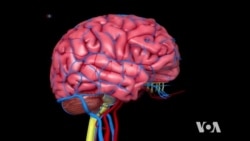Researchers and engineers keep improving the machines that help doctors better understand and diagnose conditions that affect our brains. One of the goals is to find causes of Alzheimer’s and Parkinson’s disease, which affect millions of people throughout the world.
Since the 1980s, doctors have used Magnetic Resonance Imaging machines, or MRI scanners, to look into patients’ bodies without exposing them to the harmful effects of X-rays.
An alternating magnetic field created inside the MRI's tube excites hydrogen atoms in the body’s tissues, making them emit radio waves. Those waves can be turned into pictures, similar to X-ray images.
The magnet of a new MRI, built by Siemens, has 7 tesla units, making it more than 100,000 (7/0.000065 = 107,692) times more powerful than the earth’s magnetic field.
“Using something like 7-tesla imaging, you can do very high resolution imaging, you can get the contrast that you need in order to identify the particular sub-parts of the nuclei that you need,” said Peter Jezzard, a professor of neuroimaging.
But even high-resolution two-dimensional black-and-white pictures are quite different from three-dimensional color renditions that can be viewed from all angles.
Using MRI-generated images of water molecules moving within the brain’s white matter, scientists at the British company Holoxica created a hologram showing the connections between neurons.
“The brain is such a complex three-dimensional structure, and sometimes it is quite difficult to describe, or understand, the actual connections," said neurosurgeon Basil Ridha. "So to see it in 3-D, that may be a short cut to education, and it can reinforce the learning process.”
The holographic display is still in prototype phase, but researchers say, once ready for production, it will be compatible not only with MRI machines but also with CT and ultrasound scanners.









